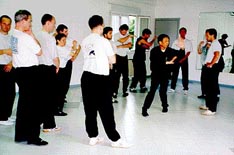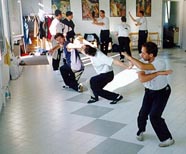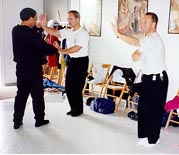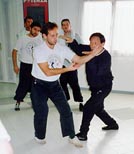 |
 |
[ Go to Bottom ]
-
 |
 |
[ Go to Bottom ]
*** Welcome ***
to the Pa Kua Chang (Ba Gua Zhang) Website of Sifu Park Bok-Nam!
We hope that you will find this site to be interesting and informative,
and will use it as a starting point for learning more about the Pa Kua Chang of Lu Shui-Tian.
|
= THIS EDITION = Featured in this edition of the FYI Page: Breathing Exercises . |
= ANNOUNCEMENTS =
Virginia Beach, VA Peter Buckman
Contact information
has been provided on the Regular
Classes page. |
|
|
QI GONG (CHI KUNG) TRAINING
Breathing Exercises
[Adapted and Re-edited by F. Hriadil]
| When
referring to Qi
or Internal development, the first aspect that should be addressed
is Breathing. It is clear that a human being can live for
a number of weeks without food and a number of days without water; but,
a person cannot survive for much more than a few minutes without
air.
Developing the ability to breathe fully and efficiently is the key to
significantly
improving a person's health and quality of life.
One replenishes the expended energy in the body by taking in both food and air. While the importance of a good diet and proper nutrition is well-understood today, the importance of the breathing process in the promotion and maintenance of good health has not received adequate recognition in western society. If one's breathing is inefficient, the body can easily expend more energy than it can replenish. This is one of the main reasons why so many people become tired and exhausted at the end of the day -- their breathing process is inefficient. They are not able to fully replenish the physical and mental energy that is expended during the day's activities. However, anyone and everyone can learn to breathe fully and efficiently through the breathing development and breath control exercises of Ba Gua Zhang. This type of training serves to strengthen the body's vital capacity and help the body rid itself of toxins and disease. It is also clear that breathing exercises and breath control techniques are key elements in developing high skill in internal martial arts practice. To effectively apply Qi or Internal Energy in a martial application or a healing application, a practitioner needs to develop proper body alignments and mechanics, the ability to concentrate Qi in his or her body, and the ability to move the Qi with the mind. This comprises the crucial trinity formula of Ba Gua Zhang Qi Gong practice FORM + BREATH + MIND which is necessary for the attainment of high skill. This is no easy task. However, through proper breathing exercises, meditation training, and other Qi Gong practice, this ability can eventually be attained. |
|
|
|
|
|
|
|
The first two foundation breathing methods are practiced, in order, before performing the prescription breathing method. These first two breaths are never changed because they serve to prepare the body to carry out the more demanding prescription breath. The prescription breath is changed as the student improves in his or her level of skill and development. The specific breathing methods are:
|
|
The second foundation breath is the Filling Breath. Most breathing exercises from the East Indian or Chinese yogic traditions focus the breath exclusively in the lower abdomen or Tan Tian. While a student must eventually learn this type of breathing, he or she must first insure that all five lobes of the lungs are operating at full capacity. Indiviuals who have never practiced breathing exercises will usually take shallow breaths. Shallow breathing only develops the upper portion of the lungs and results in very inefficient breathing. On the other hand, individuals who practice only lower abdomenal breathing exercises tend to under-utilize their upper lungs. In this circumstance, the upper chest tends to become tight and again full breathing capacity is restricted. By practicing the Filling Breath everyday before the Qi development breathing exercises, the practitioner insures that all lobes of the lungs are exercised and that the chest is operating to its full capacity. |
|
|
|
|
| Although it is recommended that
students practice
the breathing exercises before 10 AM, this is strictly a
guideline.
The primary underlying factor for consideration as to when it is best
to
practice breathing exercises is the balance of Yin and Yang in
the
air. As a rule of thumb, cold, wet air is Yin and warm, dry air
is
Yang. Therefore, if a person lives in Texas and it is summer, at
10 AM it will be too hot to practice breathing exercises efficiently
because
the Yang content is high and the energy level is low. Also, if it
has been raining for a few days, it is better for the student to even
skip
the breathing exercises for a day because the air is too wet or Yin.
It should be understood that a practitioner can benefit no matter what time of the day the breathing exercises are performed. It is simply a matter of degree and efficiency. The body will not be harmed; however, when the air is too Yin or too Yang, the benefit gained will be greatly reduced compared to the effort that is expended. Practicing in the period around sunrise will produce the greatest benefit for the least effort. |
|
|
|
|

. .
. .
.
Master Park will be returning to Italy in
May
and October of 1999 to
continue with his on-going series of European
Ba Gua Zhang workshops.
Contact information is provided in the
Seminars/Training
Camp page
for those wishing to attend the 1999
workshops/seminars
in Europe.
Register early - space is limited.
In addition, regular classes are available
in the cities of Padova and Thiene, Italy.
Contact information is provided on the
Regular
Classes page.
= = =
[ Go to Top
] [ Return
to
This
Edition Index ] [ Go To
Bottom ]
Best Wishes for the New Year!
Submit any comments, suggestions, etc. to E-Mail:
[ Go to Top ]
 |
 |